What is white mold?
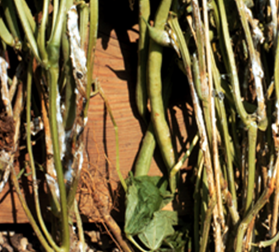
White mold, also known as Sclerotinia stem rot, is a serious and typically lethal fungal disease that affects over 400 species of plants in many plant families. White mold causes severe damage in commercially grown snap beans, kidney beans, lima beans and soybeans, as well as commercially grown sunflowers. White mold also can be a serious problem in home vegetable gardens on tomatoes, potatoes, cucurbits (e.g., cucumber, pumpkin and squash), carrots, lettuce, celery, brassicas (e.g., cabbage, broccoli, and cauliflower), basil, and rosemary. White mold is a common disease on many annual and perennial ornamentals as well.
What does white mold look like?
Symptoms of white mold vary depending on the plant infected. White mold can lead to crown and stem cankers (i.e., localized infected areas), root rots, wilts, damping-off of seedlings, and blossom and fruit rots. Plants affected by white mold can wilt rapidly due to stem-girdling cankers at or near the soil line. Brown spots can appear on flower petals and buds. Cottony masses of fungal threads (called mycelia) may appear on stems or on nearby soil. Hard, irregularly-shaped masses (called sclerotia) develop within or on the surface of infected plants. The sclerotia are white at first and then turn dark brown or black as they mature, resembling mouse or rat droppings.
Where does white mold come from?
White mold is caused by several species of the fungus Sclerotinia, most commonly Sclerotinia sclerotiorum. White mold fungi overwinter as sclerotia in dead plant material or in infested soil. Sclerotia can survive in soil for at least five years. During periods of cool, wet or humid weather, sclerotia germinate to form either fungal threads (called hyphae) or tiny, mushroom-like spore-producing structures (called apothecia). Apothecia can release millions of spores over a period of several days. Spores are dispersed primarily by wind, but also by rainsplash and insects. Both spores and hyphae can infect plant tissue, with infection often occurring through dead or declining plant parts (e.g., flowers, leaves), and then spreading to healthy tissue. Infections may also occur through healthy plant parts that are growing near or in contact with the soil. In some plants, seeds can be contaminated by sclerotia or mycelia of white mold fungi.
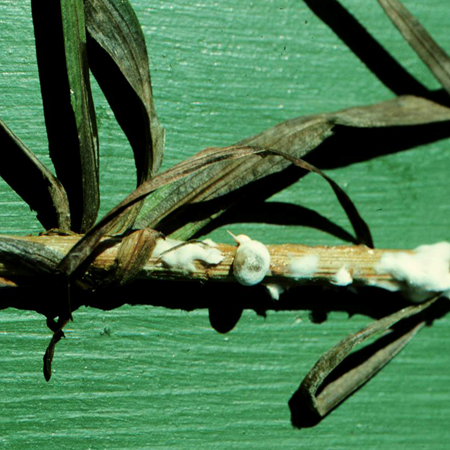
How do I save plants with white mold?
White mold is difficult to manage once infections have occurred. Prune four to five inches below obviously disease tissue or remove entire plants if they are severely affected. Do not compost these materials because of the risk of spreading white mold fungi via long-lived sclerotia. Burn these materials instead.
How do I avoid problems with white mold in the future?
Check seed for sclerotia and remove these structures if you find them. Make sure your soils are well-drained, and avoid overwatering as well as frequent, light watering. Do not overhead water (e.g., with a sprinkler). Instead water deeply early in the day with a drip or soaker hose. Promote good air circulation in your garden so that plants more rapidly dry when they do get wet (e.g., from natural rain). Better air circulation can be achieved by choosing cultivars or varieties of plants that have a more open growth form, by spacing plants farther apart, by avoiding excessive use of nitrogen fertilizers (which can promote excessive production of lush, thick foliage), and by keeping weeds under control. Weed control also eliminates potential alternate hosts that white mold fungi can infect. As leaves and flowers or your plants naturally wither and die, remove them, as well as any other plant debris that may harbor white mold fungi. Finally, in beds where severe cases of white mold have occurred, consider removing and replacing infested soil.
For more information on white mold:
Contact the University of Wisconsin Plant Disease Diagnostics Clinic (PDDC) at (608) 262-2863 or pddc@wisc.edu.
Authors: Ann Joy and Brian Hudelson, UW-Madison Plant Pathology
Last Revised: 03/02/2024
D-number: D0125
References to pesticide products in this publication are for your convenience and are not an endorsement or criticism of one product over similar products. You are responsible for using pesticides according to the manufacturer’s current label directions. Follow directions exactly to protect the environment and people from pesticide exposure. Failure to do so violates the law.
Thanks to R. Vaughan James, Karen Delahaut & Laura Jull for reviewing this document.
A complete inventory of UW Plant Disease Facts is available at the University of Wisconsin-Madison Plant Disease Diagnostics Clinic website: https://pddc.wisc.edu.
Send a Plant Sample for Analysis
Be cautious when self-diagnosing plant health issues. Very few diseases can accurately be diagnosed by eye.
Contact the UW Plant Disease Diagnostics Clinic (PDDC), and for a small fee, clinic staff can examine a plant, determine the cause of the disease/disorder, and provide advice on how to control or prevent the issue.
Download Article





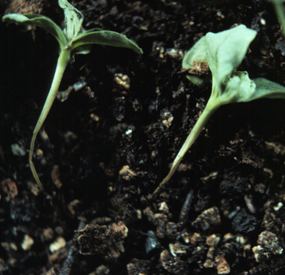 Damping Off
Damping Off Armillaria Root Disease
Armillaria Root Disease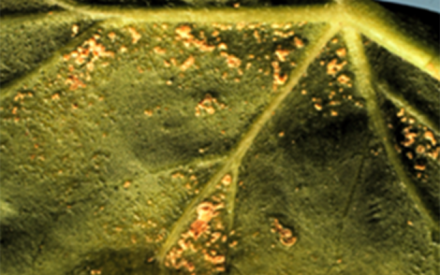 Edema
Edema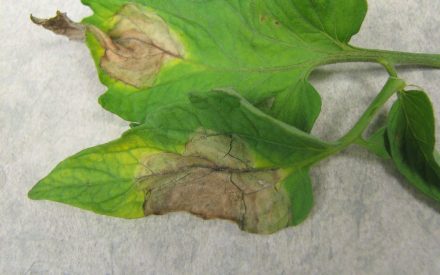 Home Garden Fungicides
Home Garden Fungicides


